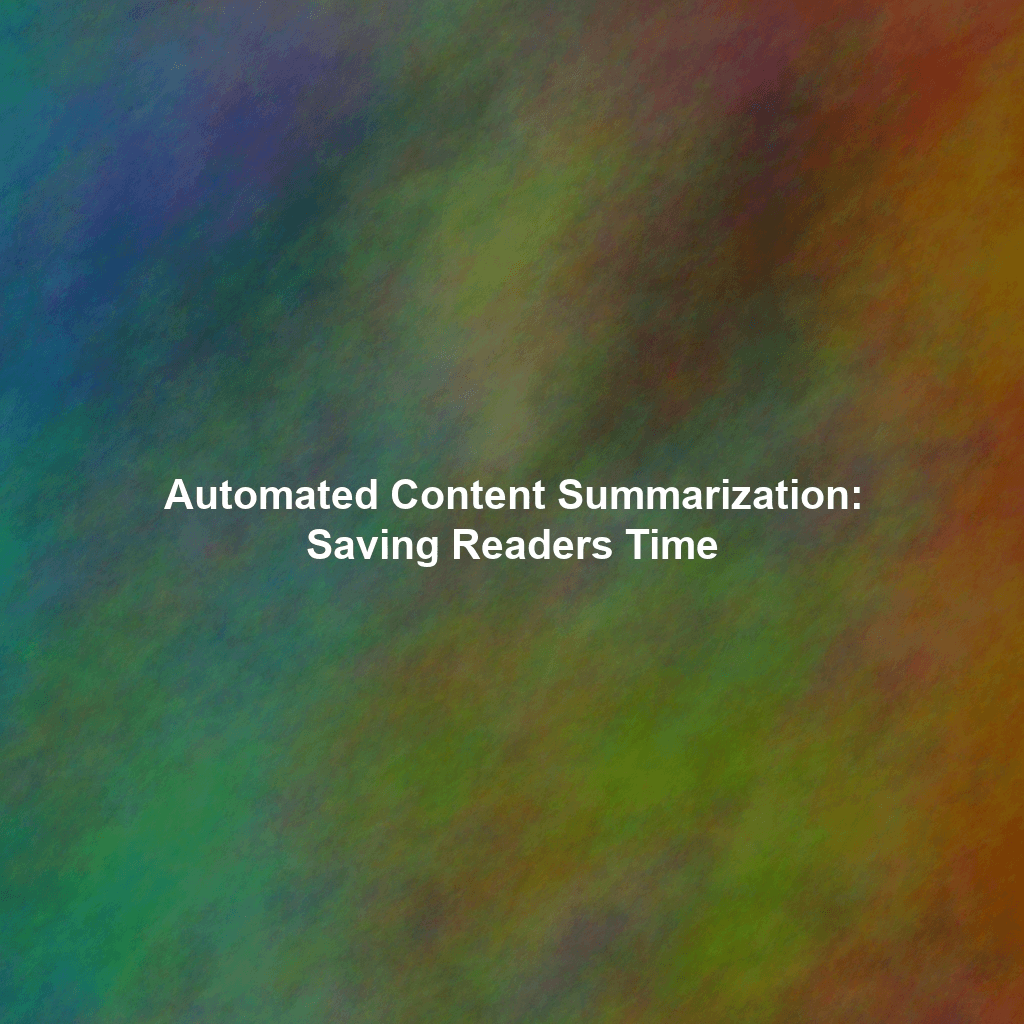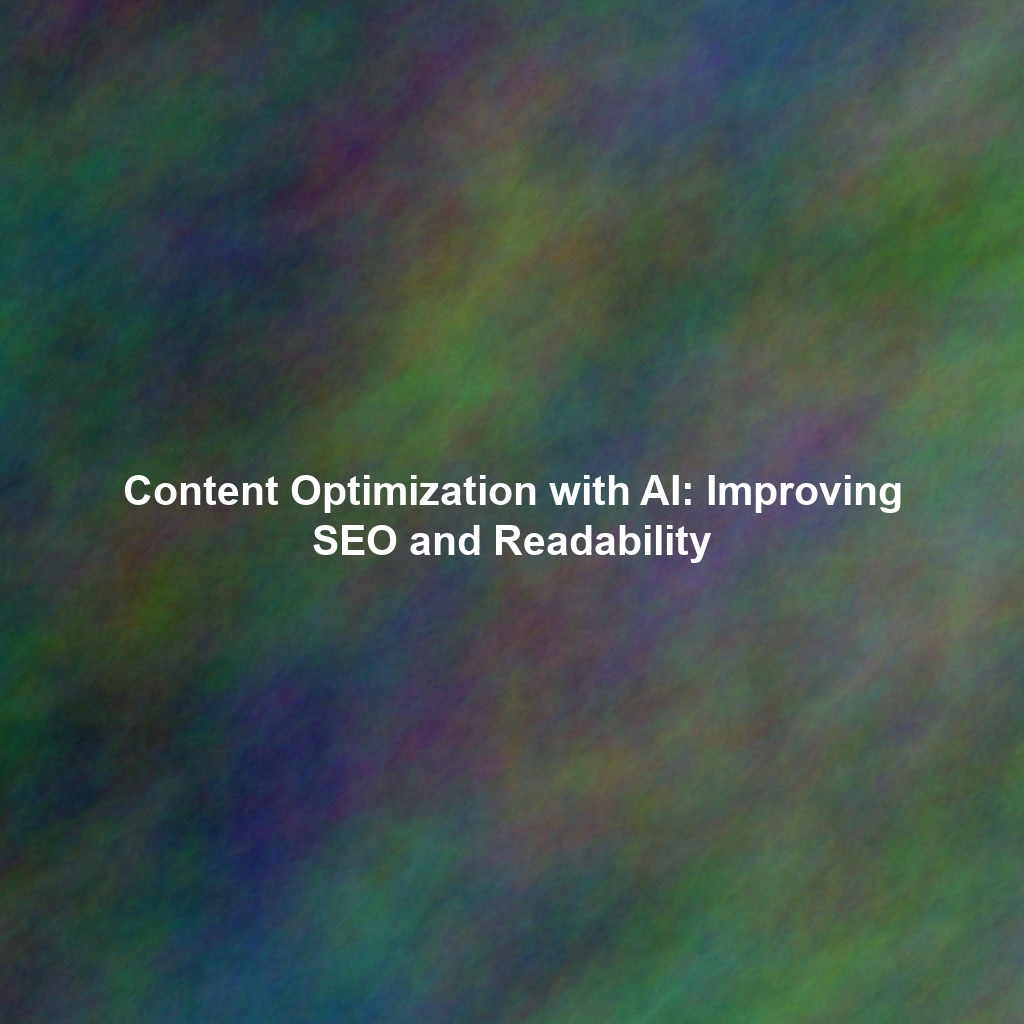Introduction: The Age of Information Overload and the Need for Concise Content
This article will delve into the world of automated content summarization, exploring its benefits, underlying technologies, and practical applications within the context of content marketing. We’ll examine how this AI-powered tool is revolutionizing the way we consume information, ultimately empowering readers to save time and make the most of the content they encounter.
What is Automated Content Summarization?
At its core, automated content summarization is the process of using computer algorithms to generate a condensed version of a text, while retaining its most important information. Think of it as a highly efficient note-taker that can quickly distill lengthy articles, reports, or documents into bite-sized summaries.
Unlike traditional human summarization, which can be time-consuming and subjective, automated content summarization offers several advantages:
- Speed: Algorithms can generate summaries in a fraction of the time it would take a human.
- Objectivity: The process is less prone to bias, as it relies on pre-defined rules and statistical analysis.
- Scalability: It can easily handle large volumes of text, making it ideal for processing vast amounts of information.
- Consistency: Algorithms consistently apply the same summarization rules, ensuring a uniform approach.
These advantages make automated content summarization an invaluable tool for anyone who needs to quickly grasp the essence of large amounts of text, from researchers and journalists to business professionals and students.
How Automated Content Summarization Works: Exploring the Techniques
Automated content summarization employs various techniques, primarily falling into two main categories: extractive and abstractive summarization.
Extractive Summarization
Extractive summarization is the simpler of the two approaches. It works by identifying the most important sentences or phrases within the original text and then combining them to create a summary. The algorithm essentially “extracts” the key information verbatim. This method relies heavily on statistical analysis to determine the importance of sentences. Common techniques include:
- Term Frequency-Inverse Document Frequency (TF-IDF): This method assigns a weight to each word in the document based on its frequency within the document and its inverse frequency across a collection of documents. Words that appear frequently in a specific document but are rare in other documents are considered more important.
- Sentence Scoring: Each sentence is assigned a score based on various factors, such as the presence of important keywords, its position within the document (e.g., sentences in the introduction or conclusion are often considered more important), and its similarity to other sentences.
- Graph-Based Ranking Algorithms: Sentences are represented as nodes in a graph, and the connections between nodes represent the similarity between sentences. Algorithms like PageRank (the algorithm behind Google’s search engine) can be used to rank sentences based on their importance within the graph.
Extractive summarization is relatively easy to implement and often produces coherent summaries, as it uses the original wording of the text. However, it may sometimes lack fluency or fail to capture the overall context of the document.
Abstractive Summarization
Abstractive summarization is a more sophisticated approach that aims to generate summaries that are not simply extracts from the original text, but rather paraphrased or reworded versions of the key information. This method requires a deeper understanding of the text’s meaning and involves techniques like:
- Natural Language Processing (NLP): NLP techniques are used to analyze the text’s grammar, syntax, and semantics, allowing the algorithm to understand the meaning of the sentences and phrases.
- Machine Learning (ML): ML models, such as sequence-to-sequence models, are trained on large datasets of text and summaries, enabling them to learn how to generate summaries that are both accurate and fluent.
- Deep Learning (DL): Deep learning models, such as recurrent neural networks (RNNs) and transformers, have achieved state-of-the-art results in abstractive summarization. These models can capture long-range dependencies in the text and generate more coherent and informative summaries.
Abstractive summarization can produce more human-like summaries that are often more concise and easier to read than extractive summaries. However, it is also more challenging to implement and requires significant computational resources and large training datasets. It also runs the risk of hallucination, where the summary contains information not present in the original text.
The Hybrid Approach
Some systems combine both extractive and abstractive methods. For example, an extractive method might first identify the most important sentences, and then an abstractive method might be used to paraphrase or reword those sentences to create a more fluent and concise summary.
Benefits of Automated Content Summarization in Content Marketing
Automated content summarization offers a multitude of benefits for content marketers, significantly improving efficiency and enhancing content strategy.
Improved Content Discovery and Research
As mentioned earlier, content marketers are constantly bombarded with information. Automated summarization tools can quickly scan and summarize multiple articles, reports, and studies, allowing marketers to identify the most relevant and insightful content for their research and content creation efforts. This can save countless hours of sifting through irrelevant information.
Enhanced Content Curation
Content curation is a crucial aspect of content marketing, involving the discovery, filtering, and sharing of valuable content from other sources. Automated summarization can streamline this process by quickly generating summaries of articles and blog posts, allowing marketers to easily assess their relevance and suitability for sharing with their audience. This helps in delivering curated content that is both informative and engaging.
Creating Concise Content Snippets for Social Media
In the fast-paced world of social media, attention spans are short. Automated summarization can be used to create concise and compelling content snippets that capture the essence of longer articles or blog posts, making them more appealing to social media users. These snippets can be used as captions, tweet threads, or even as teasers to drive traffic to the original content.
Generating Meta Descriptions for SEO
Meta descriptions are short summaries of a webpage’s content that appear in search engine results. While Google says they don’t use them as a direct ranking factor, well-crafted meta descriptions can significantly improve click-through rates. Automated summarization can be used to generate relevant and keyword-rich meta descriptions that accurately reflect the content of the page, helping to attract more organic traffic.
Analyzing Competitor Content
Keeping an eye on the competition is essential for any content marketer. Automated summarization can be used to quickly analyze competitor blog posts, articles, and white papers, providing insights into their content strategy, messaging, and target audience. This information can be used to inform your own content strategy and identify opportunities to differentiate your brand.
Improving Internal Knowledge Sharing
Within a marketing team, efficient knowledge sharing is crucial. Automated summarization can be used to condense lengthy reports, meeting minutes, or research documents, making them easier for team members to digest and understand. This fosters better collaboration and ensures that everyone is on the same page.
Real-World Applications and Examples
The practical applications of automated content summarization are vast and varied. Here are a few examples of how it’s being used in the real world:
- News Aggregators: News aggregators like Google News use summarization algorithms to provide concise summaries of news articles, allowing users to quickly scan headlines and decide which articles to read.
- Research Platforms: Scientific and academic research platforms use summarization to help researchers quickly identify relevant research papers and extract key findings from large volumes of literature.
- Legal Document Analysis: Law firms use summarization to analyze contracts, legal briefs, and other legal documents, saving valuable time and resources.
- Customer Service Chatbots: Chatbots use summarization to quickly understand customer inquiries and provide relevant information or solutions.
- Educational Tools: Students can use summarization tools to quickly grasp the main points of textbooks and research papers, making studying more efficient.
Challenges and Limitations of Automated Content Summarization
While automated content summarization offers significant benefits, it’s important to acknowledge its limitations.
Contextual Understanding
Algorithms can sometimes struggle to fully grasp the context of a text, particularly when dealing with complex or nuanced language. This can lead to summaries that are inaccurate or misleading.
Handling Ambiguity and Sarcasm
Ambiguity and sarcasm can be challenging for summarization algorithms to handle, as they often rely on subtle cues and contextual clues that are difficult to detect programmatically. This can result in summaries that misinterpret the intended meaning of the text.
Bias in Training Data
The performance of machine learning-based summarization models is heavily dependent on the quality and diversity of the training data. If the training data is biased, the model may generate summaries that perpetuate those biases.
Over-Simplification
In an attempt to create a concise summary, algorithms may sometimes over-simplify the content, omitting important details or nuances that are essential for a complete understanding of the text.
Hallucinations in Abstractive Summarization
Abstractive summarization, while more advanced, can sometimes “hallucinate” information, meaning it generates content that isn’t present in the original text. This is a significant concern, especially in fields where accuracy is paramount.
Despite these limitations, the field of automated content summarization is rapidly evolving, and researchers are constantly developing new techniques to address these challenges. As algorithms become more sophisticated and training datasets become more comprehensive, the accuracy and reliability of automated summarization will continue to improve.
Future Trends in Automated Content Summarization
The future of automated content summarization is bright, with several exciting trends on the horizon:
Improved Abstractive Summarization
Abstractive summarization is expected to become increasingly sophisticated, with algorithms capable of generating summaries that are not only concise but also more accurate, fluent, and human-like. This will be driven by advancements in deep learning, particularly in areas like transformer networks and attention mechanisms.
Multilingual Summarization
As the world becomes increasingly globalized, there is a growing need for multilingual summarization tools that can automatically summarize content in multiple languages. This will enable users to quickly access and understand information from a variety of sources, regardless of their language proficiency.
Personalized Summarization
Personalized summarization involves tailoring summaries to the specific needs and interests of individual users. This can be achieved by incorporating user preferences, search history, and other contextual information into the summarization process.
Integration with Other AI Tools
Automated content summarization is likely to be increasingly integrated with other AI tools, such as chatbots, virtual assistants, and content creation platforms. This will enable users to seamlessly access and process information within their existing workflows.
Conclusion: Embracing Automated Content Summarization for a More Efficient Future
Automated content summarization is rapidly transforming the way we consume and interact with information. By providing concise and accurate summaries of lengthy texts, it empowers readers to save time, make more informed decisions, and stay ahead of the curve. In the context of content marketing, this technology offers a powerful toolkit for improving content discovery, enhancing content curation, creating engaging social media snippets, and optimizing SEO. While challenges remain, the ongoing advancements in AI and NLP are paving the way for even more sophisticated and reliable summarization tools in the future. Embracing automated content summarization is not just about adopting a new technology; it’s about embracing a more efficient and informed future.
 Skip to content
Skip to content

